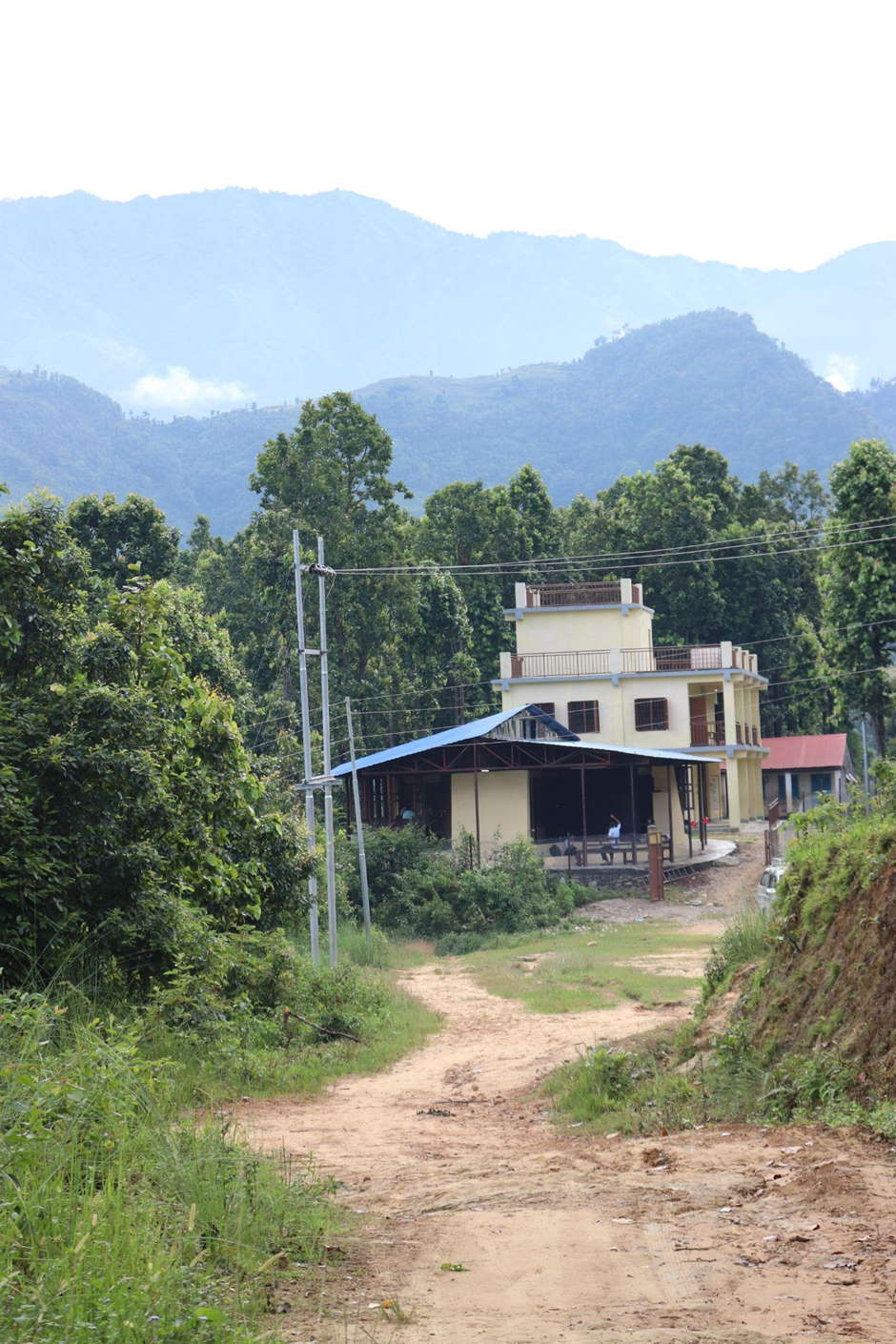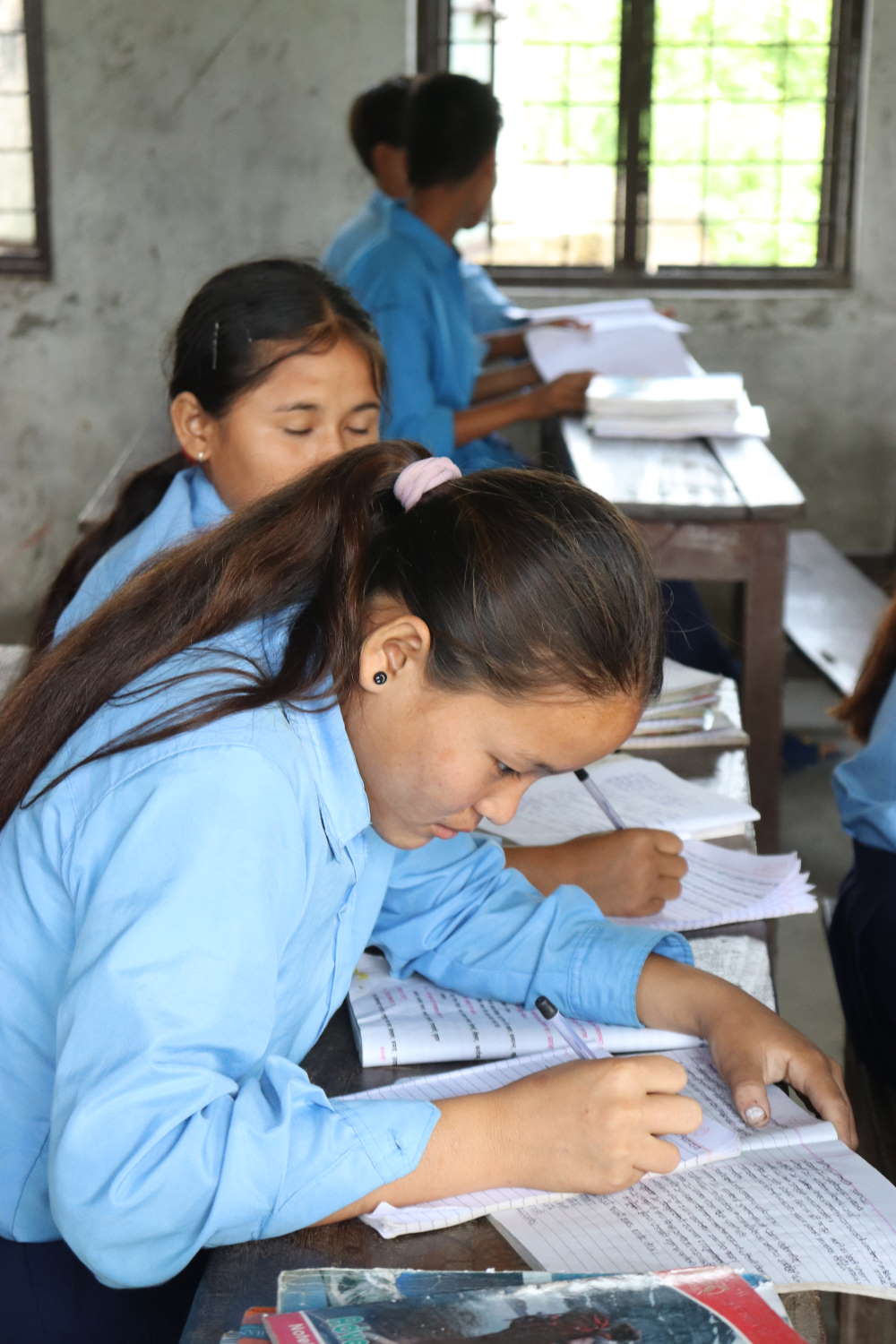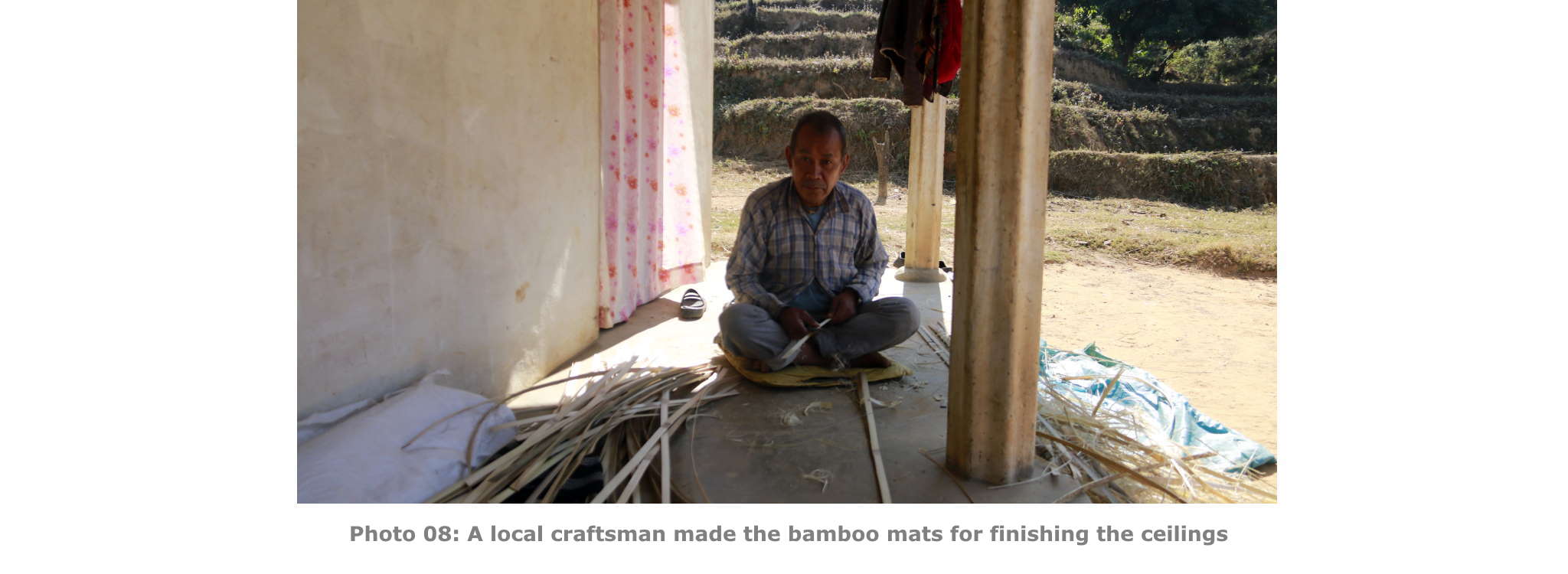
Photo 1: the inauguration sign
November 2022
All’s Well that Ends Well. And a New Beginning!
All’s well that ends well
In June, the time had finally come: the official inauguration of Kalidevi School in Chaap, Makwanpur District. The mayor cut the ribbon, unveiled the plaque listing all collaborators and officially handed over the building.
Such an inauguration is accompanied by a bindi, also called tika, a red dot on the forehead. Hindus attach different meanings to the dot: it offers protection or gives you more insight into yourself. Priests make a bindi on the forehead of the believer after praying or visiting a temple. It is a mixture of rice, water and coloured powder. The ceremony also includes a hand-woven scarf in red, the national colour of Nepal. The khada symbolizes purity and compassion and is given as a welcome and worn at all major ceremonies.
In the photo, under the inauguration sign, you can see Raju Ghalan, the mason who took on the greatest responsibility and coordinated the construction of Kalidevi School. To his left are three employees of the Centre for Educational Policies and Practices, with Teeka Bhattarai, initiator of CEPP, in the middle. To the right of the board are the teachers and the headmaster of the primary school in Chaap. Our Nepalese partners and ourselves have thought long and hard about the text on the inauguration board. We wanted to pay tribute to the strength of the Nepalese children, teachers and parents and also mention all sponsors and sympathizers.

Photo 1b The inauguration sign
This School Building of Shree Kalidevi Primary School, built in a partnership between the Centre for Educational Policies and Practices (Nepal), the Bikas Association NPO (Belgium), the KU Leuven Faculty of Architecture (Belgium), the Province of East Flanders (Belgium) and the Local Builders coordinated by Raju Ghalan is dedicated with love and respect to the present and future generations of children, teachers and parents. Chaap, Makwanpurgadhi - 2 June 2022

Photo 2: The handover ceremony
Teeka Bhattarai, education activist and coordinator of the Centre for Educational Policies and Practices, officially hands over Kalidevi School to Mr Keshab Sapkota, headmaster, in a programme attended by pupils, parents and teachers and representatives of the municipality. Since Nepal adopted a new constitution in 2015 and became a federal state, the central government in Kathmandu handed over most of the responsibilities for schools to the local governments and the rural municipalities.
The municipality of Makwanpurghadi has now asked CEPP for pedagogical support for a higher number of schools in the area, not just Kalidevi School. The local Mayor used to be a school inspector in another area where CEPP is working and has a keen interest in education.

Photo 2b The Mothers
The parents of the children from Chaap village are very much interested in the new school building and in the education that will be offered in it. Especially the mothers! Many mothers are part of a Mother Group and some belong to the School Management Committee. Part of CEPP's mission is to support these initiatives and to inform parents and children of their right to quality education, Goal 4 of the 17 sustainable development goals set by the United Nations Organisation (UN).

Photo 3: The 17 sustainable development goals

Photo 4: Sustainable Development Goal 4 - Quality education
Link: https://www.un.org/sustainabledevelopment/wp-content/uploads/2018/09/Goal-4.pdf
And a new beginning
The official handover of Kalidevi School to the Nepalese people is an important event for us as well. The architecture department of KULeuven, campus Gent, students and docents, coordinating architect Wart Thys, graphic designer Lin Seminck, BIKAS, the province of East Flanders, the people of Chaap… were all instrumental in reaching this moment. As Klaas Vanslembrouck, one of the KULeuven docents put it: ‘’It has brought us all together, including all the students to whom this project has been a life-changing experience. It is great to see the school being handed over to its future users, now the real work can begin. As the school building is nothing but a tool that challenges people to teach children in a ‘different’ way, we hope that we will witness its impact in the future!’’

Photo 5: Kalidevi School

Photo 5b: the Kalidevi School building, as seen from a distance
The realisation of Kalidevi School constitutes an effort from the side of the Belgian architects and of CEPP to re-link the community with schools through a building that is different from what Nepalese people are used to.
CEPP and the architects try to encourage Nepali planners and designers towards having buildings that are not just focused on strength and on housing students, but that also give due consideration to the schools’ pedagogical function, that take the climatic conditions of the location into account and that support the local economy. Rather than bringing in materials from outside, the Kalidevi school building uses local knowledge and local materials.
Buildings and physical equipment of schools are a start, but the educational follow-up is also of the utmost importance.
Within Bikas, Paul Beké and Carine Verleye will now be responsible for that, in close collaboration with CEPP, with local teachers and with students from different teaching departments such as Erasmus Hogeschool Brussels.
In order to support CEPPs efforts to help improve the quality of education in rural government schools, and following their explicit request, we have made a number of educational materials to inspire the educational community in the village of Chaap and were able to send them to Nepal.

Photo 6: the first set of educational materials

Photo 7: hand knitted vegetables
The first set of materials reached Kalidevi School before the official handover of the school building to the local people. All the materials were used in the handover ceremony.
We tried to develop materials that teach children about their own lives, that are respectful of Nepalese cultures, that stimulate creativity, that are beautiful and sustainable, that are cheap and often handmade and that can be made by Nepali teachers as well. We firmly believe that Nepali people are responsible for their own development, also in education, and that they are in the best position to know what is valuable for their children. We can share our knowledge, enthusiasm and talents and develop a cooperation that is rewarding for all parties. In the picture you can see materials that we developed ourselves. We printed posters and made games that can be used to teach children the Western alphabet. We made wall hangings about vegetables and fruit, and knitted vegetables grown on the Nepalese countryside, to support CEPPs efforts to stimulate agro-ecology and healthy eating habits. We laminated pictures of the 2019 Bikas calendar, sewed a map of Nepal and laminated pictures of Nepal for a memory game. We sewed bean bags for physical education and a little mouse to teach prepositions like in, on top of, between. These materials come with printed educational support and we plan to make this support available on the Bikas website as well and to have occasional Zoom meetings with our Nepalese partners. We normally develop similar materials together with the teachers during teacher trainings 'in the field' but couldn't do so in the past two years. We sincerely hope our commitment will inspire and encourage our Nepalese partners from CEPP and from the village school(s).

Photo 8:the second set of educational materials
The second set of materials reached Nepal in October and consists of 50-year-old picture books about Nepal and the Himalayas, good to support the curriculum for Social Studies and to learn about Nepal’s history, card games to teach elementary English, jumping bags and toys for physical education etc.

Photo 9: creative materials
Creative materials, a number of illustrations (hard to come by in rural Nepal), little birds that show different emotions...

Photo 9: Veronika’s game
The card games were developed, especially for Nepal, by Veronika Rút Fulerová ( https://veronikarut.com/ ), a graphic designer from the Czech Republic, who used to study at Luca School of Arts in Ghent.So this is truly a global cooperation!

Photo 10: laminating pictures
And we spent hours in our kitchen, laminating pictures about Nepal. Old issues of the National Geographic magazine are a great resource too! We hope you will want to support CEPPs goal to improve primary education in rural government schools!
Donations on Bikas' account number BE32 2200 7878 0002, mentioning 'From School to School' will be used carefully, for the benefit of young Nepalese children!
Thank you very much. In solidarity,
Paul Beké and Carine Verleye, Wart Thys

August 2022
Brief news about the schools in Sindhuli District and about Kalidevi School in Makwanpur District
 |
| Photo 1: A newly furnished, safe, warm and attractive kindergarten classroom in Sindhuli District |
Dear reader, on the homepage of the HAKU-project you could already read about the achievements of CEPP, the Center for Educational Policies and Practices, in the four Haku schools in Rasuwa District. Supporting these schools has been a strong focus of the organisation's operations lately, and success has been forthcoming…
But of course CEPP is still committed to improving the quality of education in other districts too, working closely with teachers, students, parents and local authorities. Motivation of all those involved in education is very important, but also training of teachers, parents, school committees and local authorities is given full attention. Newly decorated classrooms are neat and child-oriented.
 |
| Photo 2: Nepalese school children rarely lack motivation. |
Greening the school environment and supporting an education that focuses on environmental protection and ecological agriculture remain important ideals that CEPP realizes in a practical way.
 |
| Photo 3: The children are responsible for the new plantings. |
However, reporting on CEPP's activities in those other areas was slow to get through to Belgium. In fact, the financial and content reports didn't reach us until June 29 and 30, too late to write an in-depth article before the journal deadline (June 24).
Beneath is a video about the transfer of Kalidevi school to the local population. The video was made by one of the CEPP employees and illustrates the transition from the construction phase to the pedagogical support phase: in the various rooms there are didactic resources available that we, respectful of the local culture and with sustainable materials have realised ourselves so as to encourage our educational partners in Nepal.
We will discuss the video in our next issue. You can already look forward to extensive news in the autumn edition of the Bikas magazine! Carine Verleye and Paul Beké

 |
| Photo 14: The school at dusk, the lights are on! |
May 2022
In previous issues of the Bikas magazine we already discussed the functioning of one of our partners in Nepal, CEPP. CEPP – Centre for Educational Policies and Practices – aims to guarantee the right to primary education by improving education policies at all levels, especially at the local school level, making use of existing facilities. They represent a comprehensive education policy in Nepal, an education policy sensitive to social, cultural and environmental issues and relevant to the community. They work closely with local communities, politicians, teachers and children, they do a lot of field work and they have a good and long tradition of working with volunteers of all kinds. Since 2016 CEPP, the architecture course of KUL in Ghent, have been working closely together with a number of architects and educators. They want to develop a school project in Nepal that, in addition to its traditional function as a place to gather and share knowledge, also tries to fulfill a community function within the village. In this way we try to achieve a higher involvement of parents, pupils, teachers and school board in school activities as a whole.
An eventful period
The last full report of the construction works in Chapp dates back to February 2020. We all know what has happened in the meantime and the project in Chapp has also been delayed due to this. After our departure (the volunteers, teachers and students) the local people continued to work hard to finish the school building
Completion of the joinery and structural work
Initially, the wooden walls and the joinery (the windows and doors) had to be completed. Both new and recovered sal wood were used for this. As you can see in the photos, a large part of the work was done manually, including sawing the beams into planks for the cladding of the walls. The specific shape of the roof gives the building its character and appearance, but also creates the expected challenges in the finish. Sal wood was used as a finish for the outside of the walls, the inside of the walls was finished with painted plywood sheets. The walls were filled with a mixture of rice-husk, cement and water. This filling ensures that the walls are windproof and have an insulation value, albeit limited. [Photo 01 to 04]
 |
 |
Subsequently, the raised 'pati' around the school building was completed. After providing a retaining wall, made of boulders and cement, the stairs could be built, ramps could be provided and the whole could be finished with natural stone tiles. The Pati wraps around the classrooms and functions as a play area, an access zone and a transition between the classrooms and the surroundings. In this way, the school building is at 'seat height' above its surroundings (safe from heavy rain and water). In this way, the pati also absorbs the largest differences in height with the environment and makes the classes easily accessible. [Photo 05 to 07]
 |
 |
Finishing the interior
The last design decisions regarding the interior and the furniture were made of necessity via online meetings and many emails with diagrams and drawings. An extra site visit in 2021 was not yet possible, and the workshops with architecture students from St Lucas / KUL could not continue for the time being. To finish the ceilings, large mats were woven by a craftsman from the village. The combination of the (industrial) steel of the roof construction and the bamboo mats gives a distinct result. [Photo 08 to 10]
 |
 |
Work continued on the interior as well. A traditional cooking area was built in the kitchen class. Traditional except for one important detail, this cooking area has a fireplace, integrated into the concrete wall, directly outside! To give the storytelling class the right atmosphere and warmth, the floor here was finished in wood, and a raised plinth in wood was provided against the sides, as a 'back' for the seated children. In addition to this wooden finish, the storytelling class also received a wooden library cabinet. Keep the stories and legends coming! [Photo 11 to 14]
 |
 |
The school in use
The school has been used during the past months, but the intention is of course that the building will be completely finished before it is officially handed over to the village and the school board. Still on the program: the last painting works, limited works on the electricity and lighting and a table and benches for the agricultural class. The photos in this publication were taken by the employees of CEPP, but we (volunteers and teachers KUL) hope that in the near future we will be able to visit the finished building ourselves to view and photograph the finished building. Due to the close cooperation with CEPP, Bikas and the teacher trainers Carine Verleye and Paul Beké, we are sure of the educational support of this project in the future. We are all curious about how the building will be used, and what we can learn from the experiences of trainees, villagers, teachers, students and volunteers.
If you also want to contribute to the Kalidevi School Project, you can do so by making a deposit to the number BE32 2200 7878 0002 of BIKAS non-profit organisation, stating 'From School to School'.
ar. Wart Thys.
This project is a collaboration between four teachers from the KUL: Ignaas Back, Klaas Vanslembrouck, Hilde Bouchez and Tom Callebaut; two teacher trainers, namely Carine Verleye and Paul Beké; architect Wart Thys and graphic artist Lin Seminck.

February 2022
Motivated teachers, a warm and beautiful classroom, a fun playground... All of this contributes to a child-oriented, happy school environment. Our partners at CEPP, the Centre for Educational Policies and Practices, support rural schools to achieve these goals.
 |
| Padma and his colleagues, educators in Jutepani, Sindhuli District, make their own teaching materials. They want to teach the children more about the local flora. |
 |
| Teachers from Hakpara, Sindhuli, paint mini versions of traditional farming tools to educate the children about their own living environment. |
 |
| The playground motivates the children to get to school on time... Photo from Jutepani, Sindhuli. |
 |
| 'From School to School' is also a collaboration between Nepalese educators and Flemish colleagues. In January 2020, Lore, Elisa and Astrid, students of the teacher training department at Erasmus Hogeschool Brussels painted this landscape in the second grade in Simras, Sindhuli. It is a faithful representation of the school environment in the village and helps the children with topics such as math, recognizing domestic and wild animals, naming colours, and telling about daily life. |
 |
| CEPP employees and the children of Simras are all attention during a training activity. |
You probably feel motivated to help CEPP and rural schools to improve the quality of primary education. Your donation on BE32 2200 7878 0002 from Bikas non-profit, with 'From School to School’ as mention, is a much appreciated support!
